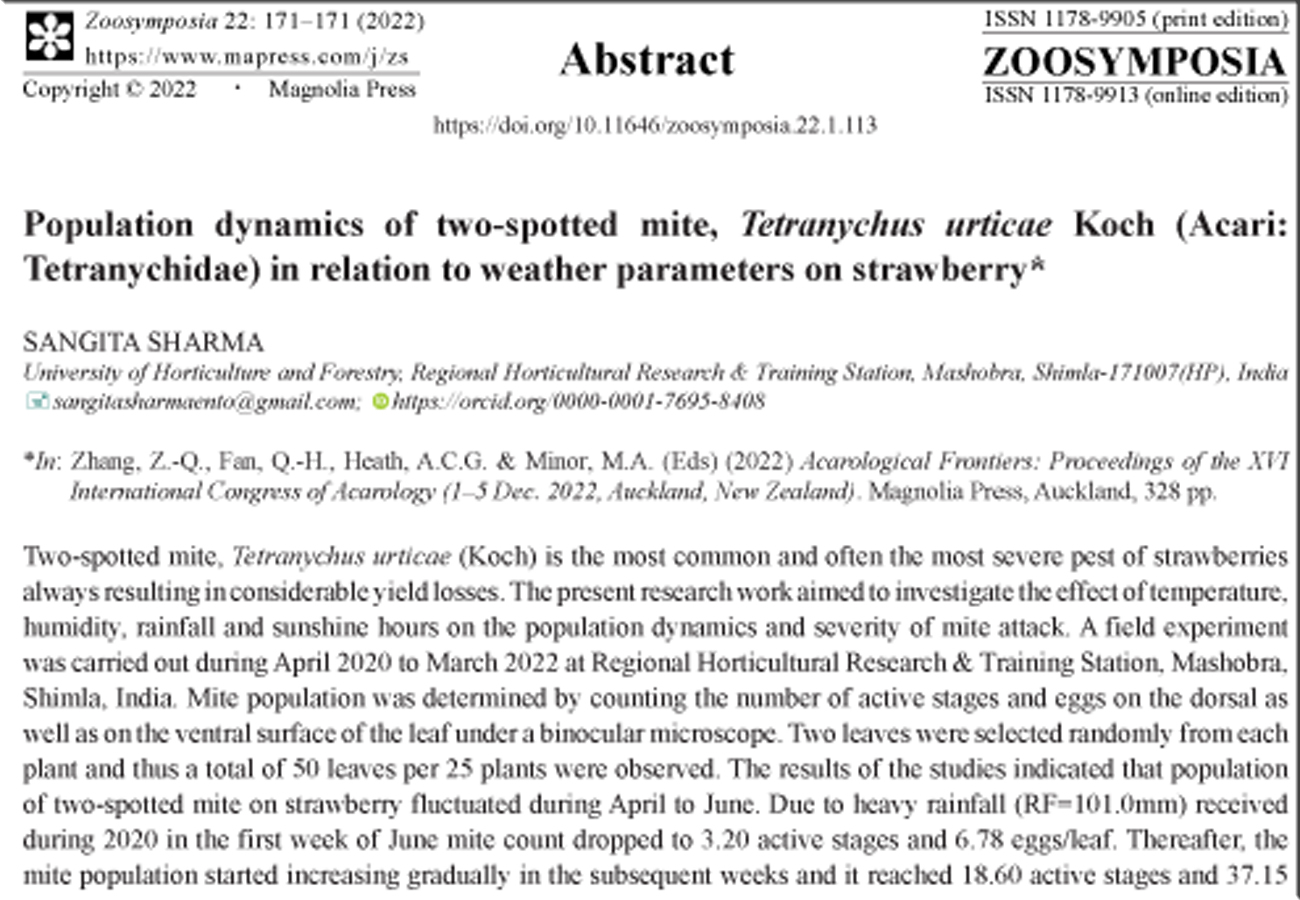Abstract
Two-spotted mite, Tetranychus urticae (Koch) is the most common and often the most severe pest of strawberries always resulting in considerable yield losses. The present research work aimed to investigate the effect of temperature, humidity, rainfall and sunshine hours on the population dynamics and severity of mite attack. A field experiment was carried out during April 2020 to March 2022 at Regional Horticultural Research & Training Station, Mashobra, Shimla, India. Mite population was determined by counting the number of active stages and eggs on the dorsal as well as on the ventral surface of the leaf under a binocular microscope. Two leaves were selected randomly from each plant and thus a total of 50 leaves per 25 plants were observed. The results of the studies indicated that population of two-spotted mite on strawberry fluctuated during April to June. Due to heavy rainfall (RF=101.0mm) received during 2020 in the first week of June mite count dropped to 3.20 active stages and 6.78 eggs/leaf. Thereafter, the mite population started increasing gradually in the subsequent weeks and it reached 18.60 active stages and 37.15 eggs/leaf by the end of June. During July-August mite population declined drastically due to washing off mites by continuous rainfall and mite count fluctuated between 0.85 to14.85 active stages and 0.83 to 27.80 eggs/leaf (Temp=17.16 to 19.28°C; RH=70.57 to 90.79%; RF=10.80 to 85.10 mm; 1.31 to 6.07 hrs) during 2020 while it reduced to minimum level of 0.30 active stages and 1.20 eggs/leaf during 2021 due to heavy rainfall (RF=143.40 mm). It multiplied with fast rate during dry months and a hike in mite count was seen from the second week of October with a peak in the fourth week of November during 2020 with the highest mean population of 89.45 active stages and 131.80eggs/leaf with mean temperature 13.51°C, 37.50% relative humidity, 0.00 mm rainfall and 8.11 hrs of sunshine. During 2021 a hike in the mite population was recorded in the fourth week of November with the highest mean population of 108.85 active stages and 186.65 eggs/leaf with mean temperature 13.05°C, 46.64% RH, 0.00 mm rainfall and 7.74 hrs of sunshine. Due to rain or snowfall received during January to February a sharp decline in mite population was observed during both seasons and it fluctuated between 1.45 to 8.35 active stages and 8.58 to 24.15 eggs/leaf (T=2.21 to7.65oC; RH=29.71 to 83.21%; RF=0.00 to 58.70 mm; SS=0.66 to 8.34 hrs). A slight hike in mite population was observed during March and mite count reached to 49.28 active stages and 76.89 eggs/leaf by the end of March, 2022 due to rise in mean temperature. The correlation coefficients (r) between mite population and temperature showed positive and significant relationship, whereas a significant but negative correlation existed between mite population and relative humidity and rainfall. The coefficient of determination between active stages and egg with weather parameters during studies ranged between 71% to 74.0% and 58 to 68.0%, respectively. Thus, the present investigations showed that the severity of mite attack on strawberry was the highest in temperature range of 13–18oC, 35–50% RH, zero rainfall, and during bright sunshine hours. These studies will help in forecasting the mite damage in advance for timely application of control measures.
References
-


